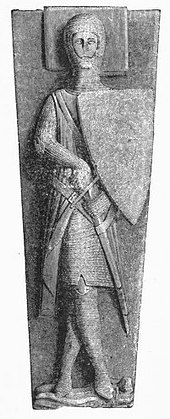Heater shield



The heater shield or heater-shaped shield is a form of
Details
Smaller than the kite shield, it was more manageable and could be used either mounted or on foot.[1] From the 15th century, it evolved into highly specialized jousting shields, often containing a bouche, a notch or "mouth" for the lance to pass through.[clarification needed] As plate armour began to cover more and more of the body, the shield grew correspondingly smaller. By the mid 14th century it was hardly seen outside of tournaments.[2]
Heater shields were typically made from thin
Contrary to the common interpretations, heater shields did not strap to the arm, but were held and maneuvered by a combination of a hand-strap and a belt called a guige, which was slung around the neck and used to support the shield, as well as sling it around the back when not in use.[4]
The heater shield was used by almost every class of society in medieval Europe, from knights to typical soldiers. This design lent itself to being relatively inexpensive and easy to make. It was relatively lightweight compared to other similar shields at the time such as the kite shield, being easy to move around during both mounted and on-foot combat, and had a fairly high amount of surface area, making for a solid defence.[5]
This style of shield was not without its flaws. When using a heater shield properly, the legs are left almost entirely unprotected. This disadvantage can be eliminated by moving away from an opponent. "When a sword flies for your leg, make a downward blow to his face or around to his throat: His arms will be wasted more quickly than his head, Because the distance is manifest for a shorter time."[5]
Unfortunately, there is very little contemporaneous documentation remaining in the world regarding the proper use of a heater shield with a sword or any other weapon.
Heater shields were often used for heraldic display, or display of the coat of arms of the wielder. This lent itself to the relatively wide surface area of the shield and its shape, which made it excellently suited for display.[citation needed]
Notes
- ^ Medieval Swordsmanship, p. 102
- ^ Arms & Armor of the Medieval Knight, p. 83
- ^ Arms & Armor of the Medieval Knight, p. 83
- ^ "Shield Straps and Holding of the Shield - end 12th Early 13th Century". 2 March 2017.
- ^ a b "Fiore de'i Liberi ~ Wiktenauer, the world's largest library of HEMA books and manuscripts ~☞ Insquequo omnes gratuiti fiant".
Bibliography
- Clements, John (1998). Medieval Swordsmanship: Illustrated Methods and Techniques, Boulder, Colorado: Paladin Press. ISBN 1-58160-004-6
- Edge, David and Paddock, John (1988). Arms & Armor of the Medieval Knight, New York: Crescent Books. ISBN 0-517-10319-2
- Grazebrook, George (1890). The Dates of Variously-shaped Shields With Coincident Dates and Examples.
- "Shield Straps and Holding of the Shield - end 12th Early 13th Century" Nathanaël Dos Reis / Translation : David Tétard (Dawn of Chivalry). 02. mars 2017. Access 20-June-2021.
